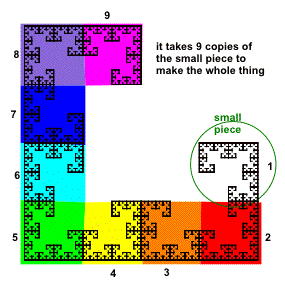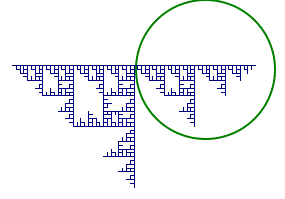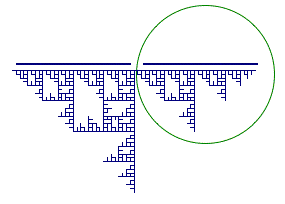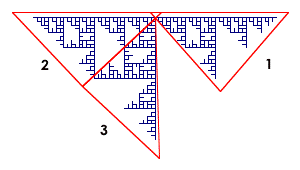

Practice question 1: If you have a self similar 2D shape where the scale factor comparing it to its smaller copies is 5, how many copies does it take to make the large 2D shape?
Ans. 25 (5x5)
2. In this Koch curve, circle two pieces that are the same shape as the whole curve, but at a different magnification. For each of your pieces, tell how much (length scale factor) you would need to magnify them to get the whole thing, and how many of them it takes to make the whole thing:
Many choices for solutions. Here are two:
 |
If I magnify this x3, I should get the whole thing, but it takes four pieces this size to make the whole |
 |
If I rotate this, and magnify it x9 it will be the same as the whole thing (magnifying x3 would give me a piece the same size as in A). If takes 16 pieces this size to get the whole thing |
3A. For the circled similar part of this Sierpinski triangle, tell the scale factor needed to enlarge it to the whole triangle, and the number of copies needed to create the whole triangle.

The scale factor is 8, and the number of copies is 27:
The total sidth is as long as 8 widths of this sized triangles. |
There are 3 this sized in the red circle (1, 2, 3). There are 3 red sized in a purple/pink, so that makes 9 so far (3+3+3). Then there are 3 of those to make a whole: 3x9=27 (9+9+9). |
B. Compare the number of copies for this scale factor to the copies needed for a 1D and 2D shape. What does this tell about the fractal dimension of the Sierpinski triangle?
A 1D shape with scale factor 8 would only need 8 copies (less than 27), and a 2D shape with scale factor 8 would need 8x8=64 copies (more than 27) so the Sierpinski triangle has a dimension between 1 and 2.
4A. For the smaller, similar part circled in this fractal, tell the scale factor to enlarge it to the larger whole curve, and the number of copies needed to create the larger whole curve.


B. Compare the number of copies for this scale factor to the copies needed for a 1D and 2D shape. What does this tell about the fractal dimension of this fractal?
A 1D shape with scale factor 4 would only need 4 copies (less than 9), and a 2D shape with scale factor 4 would need 4x4=16 copies (more than 9) so the fractal has a dimension between 1 and 2.
5. A. The biggest, and easiest similar shape to circle would be this one:

The scale factor for this one would be 2:

And the number of copies needed would be 3:

B. with a scale factor of 2, if it was 1D, you would only need 2 copies, and if it was 2D, you would need 4 copies, so the dimension of this fractal is between dimensions 1 and 2.
(more about fractal dimension here: not required for the Math 126 quiz, geeks only)
Fractals in nature: If you explain how a shape like broccolli has smaller pieces shaped like the whole, or that a lightning fork will have smaller forks breaking off of it, that tells how these things are approximately self similar.